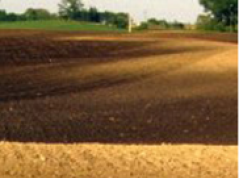
Tillage
Research (e.g. Schoorl et al., 2004) shows that the impact of soil translocation by tillage and resulting erosion rates are potentially far more important than possible parent material induced differences. Therefore, modelling erosion and sedimentation in cultivated areas not only needs to address natural processes (like overland flow) but also has to take into account the anthropogenic factor. Next to tillage erosion and sedimentation, vegetation cover under grazing regimes affects infiltration.

Technical Information
Tillage erosion is assumed to be linear with slope in LAPSUS (Schoorl et al., 2004), using the equation proposed by Govers et al. (1994):
(1.1) Still = ksf · Λ
where Still is the net downslope soil flux per tillage operation (kg m-1), ksf is the tillage transport coefficient (kg m-1) along the slope and Λ the tangent of slope (m m-1). Govers et al. (1994) calculate coefficient ksf as:
(1.2) ksf = ktd · Bd · PL
where ktd is the tillage transport coefficient (m), Bd is soil bulk density (kg m-3) and PL (m) is the depth of the plough layer. Since LAPSUS calculates soil redistribution in volume instead of weight, these two expressions combine into:
(1.3) Still = ktd · Λ · PL
with Still in m3 m-1. In calculating tillage erosion from a grid cell to its downslope neighbours, LAPSUS assigns weights to pairs of grid cells using the multiple flow principle explained above. Still can be recalculated to meter by dividing Still by the grid length dx (m).
Cattle Grazing:
Human related cattle grazing reduces vegetation cover and by that Kes and Pes values. The vegetation cover can be adapted depending on human occupation density following:
(1.4) Vhuman = V * (1 – H))
Where, Vhuman is vegetation cover (%) under human influence, V (%) is natural vegetation cover and H is human occupation density (-), with values between 0 and 1, whereby 0 is no humans and 1 is maximum human occupation density of that area in time.
See also:» Hortonian and saturation overland flow (Infiltration)